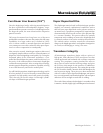
OPERATION
Operation 5
A variety of speaker cables are now available whose
manufacturers claim better performance over standard
heavy gauge wire. We have verified this in many cases, and
the improvements available are often more noticeable
than the differences between wires of different gauge. The
effects of cables may be masked if the equipment is not of
the highest quality.
We also recommend, if possible, that short runs of speaker
cable connect the power amplifier(s) and speakers and that
high-quality long interconnect cables be used to connect
the preamplifier and power amplifier. This results in the
power amplifiers being close to the speakers, which may
be practically or cosmetically difficult, but if the length of
the speaker cables can be reduced to a few meters, sonic
advantages may be obtained.
Connections are made at the Signal Input section on the
rear electronics panel of the CLS IIz. Use spade connectors
for optimum contact and ease of installation. Make certain
that all of your connections are tight.
Be consistent when connecting the speaker cables to the
Signal Input terminals. Take care to assign the same color
cable lead to the (+) terminal on both the left and right
channel speakers. If bass is nonexistent and you cannot
discern a tight, coherent image, you may need to reverse
the (+) and (–) leads on one speaker to bring the system
into proper polarity.
WARNING! Turn your amplifier off before making
or breaking any signal connections!
When you first begin to play your CLS IIz speakers allow
90 hours of break-in at 90 dB (moderate listening levels)
before any critical listening. The CLS will benefit from the
initial break in process like any conventional driver. The
membrane will flex and become more supple resulting in a
richer, more detailed and accurate sound quality compared
to the initial, out of the box, performance. Typically the bulk
of the break-in will occur in the first 90 hours but subtle
improvements will continue for quite some time.
High-Frequency Softening Switch
On the rear panel of the CLS IIz electronics module, near
the signal input, is a two position High Frequency Softening
switch that allows you to select the type of high frequency
response that you desire.
The ‘Flat’ position is considered the normal setting for
most rooms. However, due to different listening environ-
ments, different electronics characteristics and personal
preferences, you may prefer the ‘Soft’ Position. We sug-
gest that you listen to the speaker using both switch
positions and decide which position is correct for you par-
ticular situation.
Break-In


















